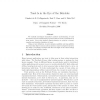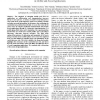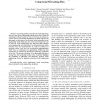CSE
2009
IEEE
14 years 6 months ago
2009
IEEE
—Constraint satisfaction has been a very successful paradigm for solving problems such as resource allocation and planning. Many of these problems pose themselves in a context in...
CSE
2009
IEEE
14 years 6 months ago
2009
IEEE
We carefully investigate humanity’s intuitive understanding of trust and extract from it fundamental properties that succinctly synthesize how trust works. From this detailed ch...
CSE
2009
IEEE
14 years 6 months ago
2009
IEEE
— Data centers accumulate corporate and personal data at a rapid pace. Driven by economy of scale and the high bandwidth of today’s network connections, more and more businesse...
CSE
2009
IEEE
14 years 6 months ago
2009
IEEE
— The emphasis of emerging mobile and Web 2.0 applications on collaboration and communication increases threats to user privacy. A serious, yet under-researched privacy risk resu...
CSE
2009
IEEE
14 years 6 months ago
2009
IEEE
—A unified electronic health record (EHR) has potentially immeasurable benefits to society, and the current healthcare industry drive to create a single EHR reflects this. Howeve...
CSE
2009
IEEE
14 years 6 months ago
2009
IEEE
Abstract—Many evidence-based trust models require the adjustment of parameters such as aging- or exploration-factors. What the literature often does not address is the systematic...
CSE
2009
IEEE
14 years 6 months ago
2009
IEEE
—Personal data is a valuable asset for service providers. To collect such data, free services are offered to users, for whom the risk of loosing privacy by subscribing to a servi...
CSE
2009
IEEE
14 years 6 months ago
2009
IEEE
—A growing number of people use social networking sites to foster social relationships among each other. While the advantages of the provided services are obvious, drawbacks on a...
CSE
2009
IEEE
14 years 6 months ago
2009
IEEE
CSE
2009
IEEE
14 years 6 months ago
2009
IEEE
—Ceremonies are a useful tool to establish trust in scenarios where protocols operate. They describe a greater range of issues not taken into account by protocol designers. We ta...



